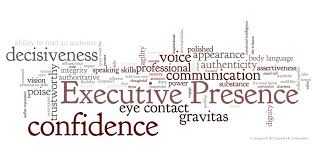
“We convince by our presence.” –— Walt Whitman.
Situation: A seat at the table
A friend of mine had this happen to her. She was a senior consultantat one of the top global accounting firms. After a few years in that position she was promoted to regional Vice President of Business Development. She was the first woman to achieve this key position which also included becoming a partner.
After her promotion, she met with the Executive Vice President and asked when she would become part of the firm’s management board. He told her another regional Vice President of Business Development was already a member and the board was hesitant to ask her to join. “We can’t have two people from business development at the table,” he added. My friend persisted. “But I’m a partner,” she said. The other partner shook his head. “I know, but the reality is that others just don’t see you as a leader.” he said.
She came to me for advice. How did this happen? How did she get promoted and then not be able to join the management board? After our many discussions and her soul searching, she made some changes. And a year after being rejected from the board, she prevailed. Not only did she become a member of the management board, in the subsequent three years she became the firm’s North American Vice President of Marketing and Business Development. “He and the others were absolutely right,” she told me. “I had the title, but that was not enough. The perception by others was that I wasn’t a leader.”
Today, as she looks back on this situation and confesses that being told she wasn’t a leader at age 48 — even with all she had accomplished — made her clearly recognize the areas where she needed to develop. “I had the confidence, competence and passion to be good at my job, but something was missing that caused the perception that I didn’t have “presence”. She gave me examples of what she believed were causing that misperception. For example, there were times when she didn’t speak up in meetings unless asked to, she sometimes didn’t stand up for what she believed in when more forceful opinions were presented and because she had not networked with leaders outside her division her accomplishments were unknown to many. One time as she rushed out the door to an early morning meeting, she mixed up her navy and black shoes, wearing one of each. Much to her embarrassment, she discovered this when her boss noticed. “I may have been a partner, but no one perceived me as one because I did not project executive presence.” She was right.
Having presence is sometimes referred to as “the person is executive material”, or “this person has leadership or executive presence”. Having executive or leadership presence is somewhat of an intangible concept—it’s not in the dictionary. It’s the ‘X’ factor that makes someone stand above the crowd. You know it when you see it.
There’s a myth that executive or leadership presence is something that you are born with, that you either have it or you don’t. While it’s true that executive presence may be more natural for some, the reality is, everyone can work on developing executive presence. Another myth is that it is only for those who want to be CEO. Anyone working with others will find having these “presence”characteristics will help them become more satisfied in their role at work and in their personal life. One can learn to have leadership presence if they have the desire and will to learn and develop characteristics. See the list of 10 characteristics for executive presence on our website.
It’s not just about how you look.
A lot of well-meaning advice on executive presence weighs heavily on a person’s outward appearance. And while it’s important to dress professionally and look the part, your appearance and clothing choices are still just superficial components. These elements represent the cover of the book. The substance of executive and leadership presence is what’s revealed inside on the pages of that book.
Try these six tips to help you cultivate genuine presence:
Cultivate authenticity. It’s not just about what suit you’re wearing, how modulated your voice is or knowing which fork to use at a formal dinner. These skills are important to have, but they’re no replacement for character and authenticity, which come from having a strong inner core of values and beliefs, and a strong sense of clarity about who you are and what you believe in. It’s critical that you find your authentic voice. Know which four or five values are important to you, and strive to model these in everything you do. Think about how you can make these a daily habit.
Exude confidence. The fast pace of business and the stress brought about by continuous change put a strain on our ability to stay composed at all times. Yet the mark of someone who has executive presence is the ability to stay cool and poised under fire. Know what your trigger points or “hot buttons” are so you can manage your emotions. People with executive presence have perfected their ability to handle all types of challenging situations they’re dealt without losing grace.
Perfect your conversation skills. Individuals with presence are able to put people at ease. One of the ways they do this is by including everyone when conversing in a group setting. Ask yourself this: When people walk away from having interacted with you, do they feel better about themselves, or worse? Have you ignored anyone in the group? Being aware of how people feel about themselves when they’re in your presence is a key aspect of leadership and executive presence. Make what you say match who you are. Act with sincerity and intention. Engage emotionally with others by being approachable and demonstrate concern toward them. Learn to listen.
Master your presentation skills. The ability to stand in front of a group of customers, peers or employees to deliver key messages with clarity, confidence and poise is a prized quality. It’s a fundamental skill for anyone who aspires to lead others. Use your voice—inflection, tone, intensity, pacing, pausing, volume—as a powerful tool to engage others, lead a conversation and command a crowd. Command attention and enthusiasm for your subject by adding purpose and animation to your facial expression and your movements. Balance your weight on both feet, with one foot slightly ahead of the other. Avoid leaning or swaying. Vary your speaking rate according to your changing intentions. A fast delivery suggests knowledge, passion, and excitement about your message. A slow delivery adds intensity, impact, and importance to your words. Use gestures that show enthusiasm, informality, relaxation, and openness. You may want to work with an experienced coach to help you learn the tips and techniques of professional speakers.
Seek feedback. If you’re a team leader or manager unable to organize your troops or get past the gatekeeper to speak to the executive decision-makers, get some feedback about how you can improve your executive presence. If you are having trouble negotiating salary increases or closing deals, ask andbe open to constructive feedback. Voltaire once said, “The only way to truly see yourself is in the reflection of someone else’s eyes.” Ask a trusted advisor, mentor, colleague, professional coach or sponsor to give you constructive feedback so you can take steps to manage the perceptions others have of you.
Own your Physical Presence. Walk with a regal posture, head held high, shoulders back, feeling tall, proud, and self-assured. Walk, move, and gesture with energy. Your passion about ideas, projects, and life in general engages others. Wear clothing that draws attention to you as a person, not an object. While outward appearance isn’t the whole story about you, it’s the opening chapter. Make it impactful and others will want to read the rest of the book.
Having leadership or executive presence is a powerful tool in your leadership toolkit, because it gets people to pay attention to you and to respect you. It gives you real and earned authority, not just position power. This authority and respect help to inspire and influence others to achieve important company goals or achieve extraordinary results.
If you would like to learn more about your current status of Executive Presence characteristics, take our “Executive Presence Questionnaire”. It will give you some insights into how you see yourself and whether you feel you have the elements of strong presence.
See you next week with the last tip of the series – 10 Weeks of Executive and Leadership Presence Tips – #10 Vision
#ExecutivePresence #Leadership #Presentationskills #Gravitas

Leave a Reply